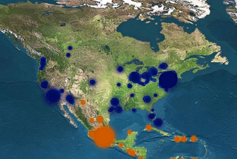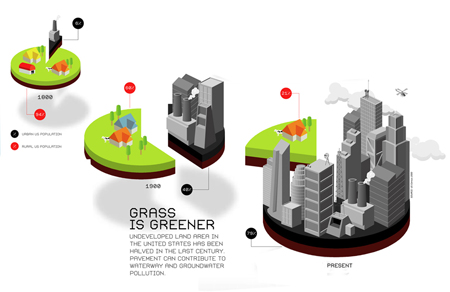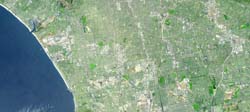2. Urbanisation
North America

The degree of urbanisation is most advanced in North America and Australia. Most Americans are urban dwellers, fewer than 5% are farmers (Bronger 1996, Renwick, Rubenstein 1995).
Between 1950 and 1990 the population of the USA increased by 65% and reached 248.7 million, 303.8 million in 2008. In Canada it increased by 95% to reach 27.3 million (33.2 million in 2008). The proportion of population living in urban areas grew from 64% to 82% in the US and from 61% to 77% in Canada (CIA World Fact Book, Pacione 2001).
Socio-demographic change, internal migration movements and immigration transformed the urban structure in North America. After the Second World War a 'marriage and baby boom' began, contributing to a rapid growth of the consumer economy, increasing housing demand and new residential construction as well as the evolution of new urban forms through widespread suburbanisation. From 1960 to about 1975, a clear trend of suburbanisation with fast population growth rates in rural, urbanising rural and suburban municipalities became the norm. Parallel to these, changes were encountered in household and family composition. In the USA today, over 20% of all households have only one person and 13% are female-headed single-parent households. These changes contributed substantially to a greater consumption of housing space (Pacione 2001, UN-HABITAT 2006).
Additionally, internal migration flows with high levels of mobility are of greater importance as determinants of urban growth and population redistribution than natural population increase. Because of a declining rate in the natural increase of population, immigration has grown in importance as a factor in population change. "Most international migrants are attracted by job opportunities and follow earlier migration paths established by friends and kin." (Pacione 2001).
Factors underlying urban growth
- The fastest-growing urban areas in the USA were smaller metropolitan areas with economies based on retirement and recreational pursuits (e.g. Fort Pierce, Florida). Most of these places are in Florida, Arizona and Nevada.
- Larger cities, acting as 'control and management' centres for the national economy in finance and services, for example New York grew by 14.5% during the last decades.
- Cities involved primarily in public administration as national, state, provincial capitals or military centers grew by 17.5%.
- Manufacturing-based cities grew only slightly while mining and resource communities declined slightly.
- Other cities have grown as regional service centres (e.g. Dallas and Atlanta), as hosts for expanding high-technology industries (e.g. Silicon Valley).
Future patterns of urban growth in North America will still be influenced by the high levels of population and economic mobility as well as by trends like immigration, an ageing population, lifestyle changes, the uncertain growth in income, government policies, technological innovations, trade liberalisation and increased global competition (Pacione 2001).
"America is the trend setter in globalising economy, skyscrapers, mega-malls, event-cities, gated communities. America is also the trend setter of growing counterurbanisation, suburbanisation, urban sprawl and exurbanisation"(Lichtenberger 2002).
Tasks: 1. Summarise the urbanisation process in North America.
2. Project the urban future in this region. Where will it lead to?
Case study: Los Angeles


